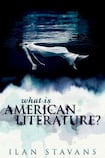
“Books keep the evidence so readers might find it tomorrow,” writes Ilan Stavans, a professor of cultural studies at Amherst College in Massachusetts. It’s a nice way of expressing the nature of literature as a permanent record, from the first written word to today, when physical books – where the reader owns the words and doesn’t just have a licence to read them as long as Amazon allows it – have remained stubbornly popular.
But how does this square with Stavans’s assertion elsewhere in his book that “the book industry is in crisis” because “people aren’t consuming them...the number of buyers is on the descent”? Does evidence exist if nobody is reading it? Is it even true that people are reading less? (Perhaps unsurprisingly, 2020 saw a big leap in time spent reading, according to US figures.)
These cross-currents are perhaps an inevitable feature of What Is American Literature?, which attempts to cover a huge topic – the national identity of the US through its literature – in less than 200 pages. But even allowing for this inherent difficulty, the results are equal parts fascinating and frustrating.
Stavans is at his best when writing about the literature and history of America’s past – the settled element. The US is a young nation, which means its most established literary classics are less than 200 years old: Edgar Allan Poe’s stories of the 1840s; Herman Melville’s Moby-Dick (1851); Nathaniel Hawthorne’s The Scarlet Letter (1850). To go further back Americans, as Stavans puts it, “see Shakespeare as their source...His marketability is such that American publishers can’t get enough of him”.
The two books he identifies as the origins of modern American literature are Mark Twain’s 1884 novel The Adventures of Huckleberry Finn (which, interestingly, was published in the UK shortly before it was published in the US) and Walt Whitman’s poetry collection Leaves of Grass. The latter is hard to date because although Whitman first published it in 1855, he continued to add to it throughout his life. But it is this very self-renewing quality, its looseness and newness (“I hear America singing, the varied carols I hear”) that makes Leaves of Grass apt as “a book that is capable of fostering a nation”.
Huckleberry Finn is another, knottier matter entirely. Despite Twain’s warning at the start that “persons attempting to fund a motive in this narrative will be prosecuted”, it’s been widely read as a metaphor for the American journey – the search for freedom. Yet the book has been as controversial as it is popular, originally because it was considered “trash”, but now often relating to the character of freed slave Jim.
Huckleberry Finn, as Stavans notes, has been one of the few victims of cancel culture from both sides of the political divide: a school in Philadelphia banned its teaching because of its use of the n-word, while a publisher who issued a version of the book with the word removed caused even more of a commotion.
As the great melting pot, the US is enriched by its immigrant literature (Stavans’s Mexican origins mean he provides guidance on Hispanic-American literature), but has also provided plenty of emigrants to spread the country’s essence further afield, including TS Eliot, Gertrude Stein and James Baldwin.
The book is most useful when acting as a sort of annotated list of essential reading. Much of it is predictable, to be sure, but it’s worth being reminded of writers in danger of slipping from public consciousness, such as Isaac Bashevis Singer, or of those writing in genres not often included in the canon, such as Ursula K LeGuin. (He’s good, too, on why science fiction is so popular in US culture.)
Where Stavans falls down is when he tries to bring the book up to date. Aside from already dated references (“the promise of a federally-approved [Covid] vaccine is on the horizon but still appears remote”), this comes out in two-page footnotes about irrelevant topics, including memes, dreams and Trump’s border policy, and a whole chapter on the risks and culture of autocorrect.
Worse than this is the sloppiness in basic details , which is so widespread it casts doubt on Stavans’s reliability elsewhere. He makes careless use of ambiguous words such as enormity and disinterest,while getting wrong the title of one of the 20th century’s most famous novels (Lady Chatterley’s Lovers, anyone?) and mangling William Faulkner’s line, “The past is never dead. It’s not even past” (while commenting on others misquoting it).
Still, the books are the thing – in literature “you belong”, as F Scott Fitzgerald put it in This Side of Paradise. “In America,” says Stavans, “nobody gives a damn what critics say.” Which is just as well, really.














